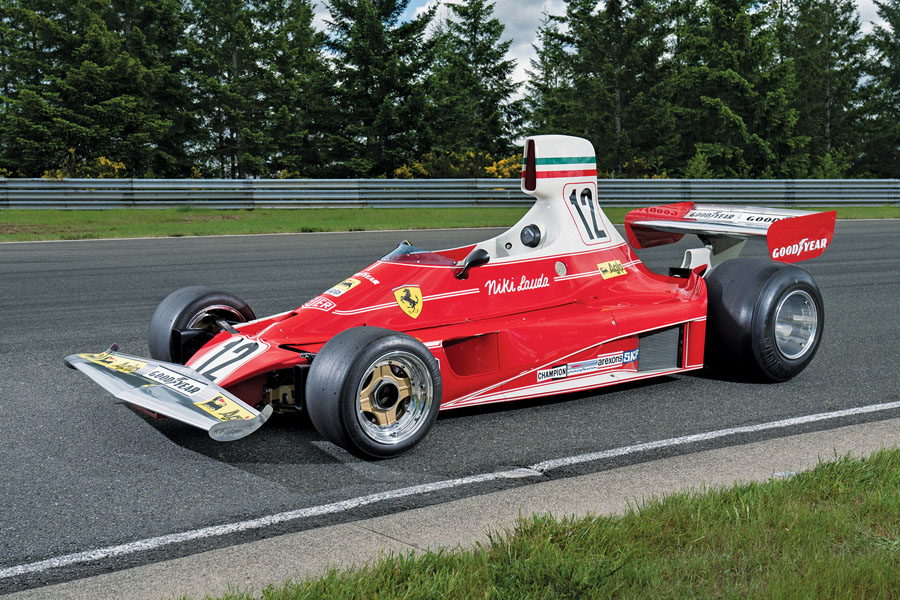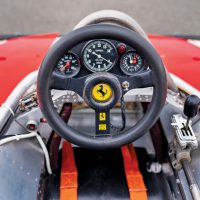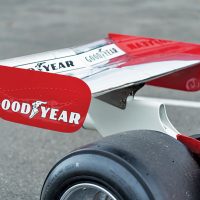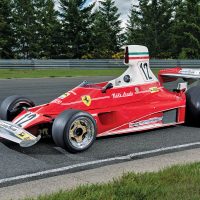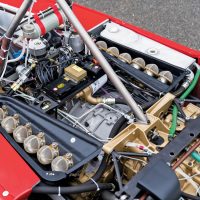SCM Analysis
Detailing
| Vehicle: | 1975 Ferrari 312T Niki Lauda |
| Years Produced: | 1975 |
| Number Produced: | Six (five survive) |
| Original List Price: | N/A |
| SCM Valuation: | Valuation: $6 million (this car) |
| Chassis Number Location: | Tag above driver’s knees |
| Engine Number Location: | Top of block at back |
| Club Info: | Masters Historic Formula One USA |
| Website: | http://www.mastershistoricracing.com |
| Alternatives: | 1975 McLaren M 23, 1975 Brabham BT 44B, 1975 Tyrell 007 |
| Investment Grade: | A |
This car, Lot 31, sold for $6,000,000, including buyer’s commission, at Gooding & Company’s Pebble Beach Auction on August 16, 2019.
A unique, niche-market car has distinct advantages in challenging times.
This was a difficult year for many cars at auction during Monterey Car Week. However, a few cars managed to sell for historic high prices with lots of market enthusiasm — and this car was one of them.
It is interesting to consider why our subject car did so well, but first we should understand the car and its specific market.
From tough times…
The early 1970s were not a good time for Ferrari’s Formula One program. Their 312B series of cars sounded great — but offered little more in terms of competitiveness. They really weren’t half-bad cars, but this was the era of the English “garagiste” teams — small, nimble, highly inventive groups who had access to utterly dominant engines and drivetrains in the Cosworth DFV and Hewland transaxles.
Not having to worry about the engine and drivetrain allowed small teams to compete with innovation in chassis and aerodynamics. At the same time, full factory teams, such as Ferrari and BRM, still built their own components and had to contend with far greater headaches.
The headaches weren’t just technical.
Designing, developing, and fielding competitive racing engines was a huge financial burden, and Ferrari was still trying to support their racing endeavors by selling street cars.
Then two big things changed: Ferrari dropped their endurance and sports-prototype racing programs to focus strictly on Formula One. Then Fiat stepped in with plenty of money and bought the road-car side of the business. These moves created substantial organizational and team changes, and Luca di Montezemolo took full control of the racing team.
Luca di Montezemolo brought Mauro Forghieri back as chief designer — and looked around for new driving talent, signing Clay Regazzoni and Niki Lauda away from the BRM team. Thus, beginning in 1974, Ferrari’s prospects improved substantially with the heavily revised 312B3. From seeing neither a pole position nor a race win in 1973, Ferrari went to challenging the Drivers’ Championship and getting 2nd in the Constructors’ Championship in 1974.
Lauda managed nine pole positions and won two races, while Regazzoni won Germany and placed well enough in the others to barely lose the championship to Fittipaldi in the last race of the season.
…To great times
1975 dawned bright for Ferrari. They had a well-organized team, excellent technical staff, two great drivers — and enough money to use them effectively.
On top of that, they had a new car, the 312T. It ran an evolution of Ferrari’s flat-12 engine, which was light and had long been powerful — but was now almost DFV reliable. The 312T made a major packaging change with a transverse (crosswise) transaxle that allowed its mass to be moved forward to ahead of the rear axle. The resulting lower polar moment of inertia combined with an improved suspension and stiffer monocoque tub to substantially improve handling.
The new 312T was suddenly the most sophisticated design in Formula One — and with little question it was the fastest. After years in the wilderness, Ferrari had returned with a classically Italian jewel, which was not only fast and easy to drive, but beautiful and watch-like in its precision and detail.
We had a successor 312T2 some years back, and I would sit for hours and marvel at how form, function, and artistry were combined into a single racing automobile.
Domination
Niki Lauda often referred to 1975 as “the unbelievable year.” He won five races to win the Drivers’ Championship by a large margin, and Regazzoni won at Monza, giving Ferrari its first Constructors’ Championship since 1964. This was the beginning of Ferrari’s hat trick of three consecutive Constructor’s Championships with variants of the 312T: 1976 with the 312T2 (Lauda lost the Drivers’ Championship by one point), and 1977 with Lauda and Ferrari both winning with the 312T2b.
Few cars in F1 history have managed to be so dominant for so many seasons as the 312T.
Now a big winner with bidders
The 312T series of Ferraris are highly desirable to a wide variety of potential buyers.
From a collector/user standpoint, the cars are sweet and uncomplicated rides. A normally sized person can fit in comfortably, the engine starts with the push of a button, it can be maintained and run with a competent — but not specialist — crew, and the driving is sublime. These cars are known for having very secure, neutral handling and a user-friendly character throughout.
From a Formula One collector’s standpoint, the 312T is historically significant in representing the return of Ferrari to the front of Formula One, for its technological advances, and for its centrality to a number of the greatest heroic drives and white-knuckle finishes in F1 history. It is difficult to conceive of a comprehensive Formula One collection that does not include one.
Generalist Ferrari collectors would be attracted for all of the reasons above, plus the simple fact that the 312Ts are flat-out gorgeous pieces of sculpture. Save maybe the “spaghetti exhaust” 312s of the late 1960s, there just isn’t a more charismatic Ferrari Formula One to anchor a collection.
Pluses and minuses
Given its significance, there was no shortage of interested parties when this car became available, but there are value-limiting factors as well.
An interesting factor is history: The most iconic Formula One car is not considered particularly collectible unless it has won at least one GP (and, of course, the more wins, the better), which is a weird but almost inviolable constraint.
Our subject car, chassis 22, was in fact a Lauda ride, but it only had one GP and one non-championship win to its name. The sister car, #23, has six wins and is thus far more desirable.
Originality is a strange consideration. A museum collector prizes originality down to peeling decals, cracked paint, and track grime still stuck to the chassis, but this doesn’t work if you intend to drive the car — or want a gleaming centerpiece to a vanity collection.
So we end up with competing values.
This car was set up as a serious driver, with engine and suspension extensively gone through at the factory with appropriate replacement parts and all but perfect paint, so its originality was a bit compromised and its desirability depended on the buyer’s intentions.
In the end, this car sold for a lot of money for a Formula One car in a public sale. It almost broke the record, but the fact that it went for minimum estimate suggests that the seller was a bit disappointed.
The general Ferrari market peaked in 2014 and has softened ever since, while the Formula One market has been very strong during the past four to five years, so there is a balance here as well.
I will suggest that the hammer price represents a very fair valuation for an excellent — but not quite ultimate — 312T. This car was fairly bought and sold. ♦
Thor Thorson wrote his first SCM story in 2003. He’s been our resident race-car expert ever since.
